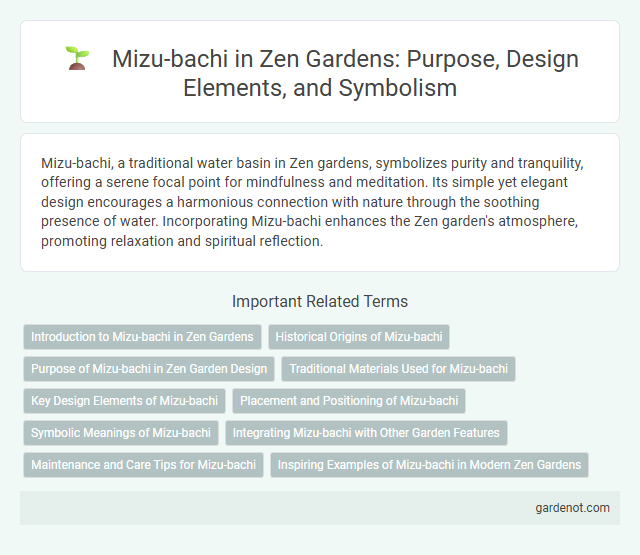Mizu-bachi, a traditional water basin in Zen gardens, symbolizes purity and tranquility, offering a serene focal point for mindfulness and meditation. Its simple yet elegant design encourages a harmonious connection with nature through the soothing presence of water. Incorporating Mizu-bachi enhances the Zen garden's atmosphere, promoting relaxation and spiritual reflection.
Introduction to Mizu-bachi in Zen Gardens
Mizu-bachi, a traditional water basin commonly found in Zen gardens, symbolizes purity and the transient nature of life through its simple, natural design. Crafted from stone or ceramic, these basins collect rainwater, inviting mindfulness and ritual cleansing before entering sacred spaces. Their placement enhances the garden's serene atmosphere, fostering contemplation and spiritual harmony.
Historical Origins of Mizu-bachi
Mizu-bachi, traditional Japanese water basins, trace their origins to Zen Buddhism and Japanese tea ceremonies during the Muromachi period (1336-1573), symbolizing purity and spiritual cleansing. These stone basins were integral in temple gardens, designed to facilitate ritual handwashing before meditation or tea preparation. Their historical significance reflects Zen principles of simplicity, mindfulness, and harmony with nature, emphasizing the meditative experience.
Purpose of Mizu-bachi in Zen Garden Design
Mizu-bachi, a shallow water basin in Zen garden design, serves as a symbolic element for purity and tranquility, inviting mindfulness and reflection. Positioned strategically near pathways or seating areas, it encourages visitors to pause and engage with the natural surroundings, enhancing the meditative atmosphere. The gentle sound and visual presence of water in Mizu-bachi also harmonize the garden's aesthetics, embodying Zen principles of simplicity and balance.
Traditional Materials Used for Mizu-bachi
Traditional Mizu-bachi are crafted from natural materials such as ceramic, stone, and bamboo, which harmonize with the Zen garden's aesthetic principles. Ceramic Mizu-bachi often feature glazes that enhance their earthy tones, while stone bowls offer durability and a connection to the garden's natural elements. Bamboo variants provide a lightweight, sustainable option that complements the tranquil atmosphere of the Zen space.
Key Design Elements of Mizu-bachi
Mizu-bachi, a traditional water basin in Zen gardens, features key design elements such as natural stone craftsmanship, smooth rounded edges, and a shallow depression to hold water gently. Its serene surface reflects surrounding elements, emphasizing simplicity and tranquility in the garden's aesthetic. The placement near bamboo water spouts enhances the meditative sound of flowing water, reinforcing mindfulness in Zen practices.
Placement and Positioning of Mizu-bachi
Mizu-bachi, traditional Japanese water basins, are strategically placed near pathways or seating areas in Zen gardens to encourage contemplation and purification. Optimal positioning involves situating the basin where natural water flow or gentle rainwater can replenish it, enhancing its symbolic connection to nature. Careful alignment with surrounding stones and plants creates a harmonious focal point that supports the garden's meditative ambiance.
Symbolic Meanings of Mizu-bachi
Mizu-bachi, a traditional water basin in Zen gardens, symbolizes purity and mindfulness, encouraging visitors to cleanse their hands and minds before entering sacred spaces. The reflective surface of the water embodies tranquility and the impermanence of life, inviting contemplation. Its presence reinforces the Zen principles of simplicity, harmony, and spiritual renewal.
Integrating Mizu-bachi with Other Garden Features
Integrating Mizu-bachi with other garden features enhances the Zen garden's harmony by combining water elements with rocks, plants, and sand patterns to evoke tranquility and balance. Positioning the Mizu-bachi near moss or bamboo creates a naturalistic setting that encourages mindfulness and reflection. Strategic placement alongside stepping stones or a tsukubai basin amplifies the sensory experience, reinforcing the garden's meditative purpose.
Maintenance and Care Tips for Mizu-bachi
Regular cleaning of Mizu-bachi prevents algae buildup and ensures clear water, crucial for maintaining its serene aesthetic. Replace the water frequently, ideally every two to three days, to avoid stagnation and support aquatic life if present. Use a soft brush to gently scrub the basin's surface and rinse with clean water to preserve its natural texture and appearance.
Inspiring Examples of Mizu-bachi in Modern Zen Gardens
Mizu-bachi, or water bowls, serve as sacred elements in modern Zen gardens, symbolizing purity and inviting mindfulness through their serene presence. These carefully crafted bowls often incorporate natural materials such as stone and metal, harmonizing with surrounding greenery to create tranquil focal points. Contemporary designs emphasize minimalist aesthetics and functionality, inspiring meditation practices and enhancing the sensory experience within Zen garden landscapes.
Mizu-bachi Infographic

 gardenot.com
gardenot.com